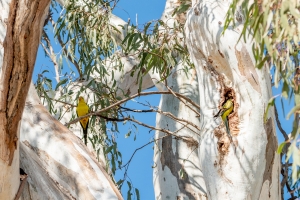Latest news
22 September 2021
Meet the regent parrot
This distinctive yellow and green bird can be found across the Murray River floodplains in north-western Victoria.
We spoke to Alex Holmes, terrestrial zoologist and fauna lead for VMFRP, to find out more about this popular bird.

The regent parrot is listed as vulnerable in Victoria and at the Commonwealth level
The regent parrot is unique because it needs access to two types of habitat – the Mallee landscape for feeding and the river country (or floodplains) for breeding. Recent research shows that they will also forage on the lakebed when the floodplain is dry, suggesting that they are well adapted to the wet and dry cycles needed to keep the Murray and its floodplains healthy.
Regent parrots are quite particular when it comes to finding the right red gum hollow for nesting. They favour healthy, living gum trees close to the water. Young gums won’t cut it as it can take a few hundred years for good-sized hollows to appear.
“We currently see the highest concentration of regent parrots nesting in colonies at Belsar-Yungera and Hattah Lakes, where we still have larger areas of century-old gum trees” explained Alex Holmes, a terrestrial zoologist and the ecologist responsible for coordinating the fauna surveys across all VMFRP sites.
Once the eggs arrive, dad does all the foraging, sometimes travelling up to 20 km a day for food. When the eggs hatch, mum and dad share feeding duties. They are super discrete when returning to the nest to avoid detection by hungry goannas and carpet pythons. This secretive approach makes them challenging to monitor!
This vibrant bird is now found in less places and in lower numbers, mainly due to land clearing and loss of nesting and foraging habitat, deliberate killing of birds, road kills and accidental poisoning.
“We’re still learning about what regent parrots need to survive and thrive,” added Alex. “But we know they rely on healthy floodplains and that their nesting habitat has contracted significantly as we’ve cut down historic red gums.”
Under the environment assessment process, Alex and his team are building on multiple previous fauna surveys and revisiting VMFRP sites to check and verify potential nesting habitats and active nests.
“Our surveys currently show no active nests located along the VMFRP infrastructure footprints,” said Alex. “We are flagging where construction work and vegetation removal could be noisy for neighbouring nesting colonies so that schedules can be adjusted to do this work outside of the breeding season.”
“That said, we know from the infrastructure built at Hattah Lakes under The Living Murray program that the parrots nesting around Oatey’s and Messenger’s regulators seem unphased by the presence of the noise from regulators and pumps.”
Alex is keen to see these floodplain restoration projects go ahead.
“At this moment in time, the ‘do-nothing’ scenario looks grim. If we don’t address the frequency and extent of inundation events, the future doesn’t look very promising for flood dependent species like the regent parrot.”
Bio
 Alex Holmes (pictured here with Jedi the lace monitor) is a terrestrial zoologist. Alex has been involved in a range of fauna surveys across the VMFRP sites for the last 20 years and has coordinated fauna surveys in all states and territories in Australia and internationally. Alex is working as the Fauna Lead for VMFRP and is coordinating several fauna surveys across all the sites in spring 2021 targeting threatened birds, reptiles, mammals and amphibians.
Alex Holmes (pictured here with Jedi the lace monitor) is a terrestrial zoologist. Alex has been involved in a range of fauna surveys across the VMFRP sites for the last 20 years and has coordinated fauna surveys in all states and territories in Australia and internationally. Alex is working as the Fauna Lead for VMFRP and is coordinating several fauna surveys across all the sites in spring 2021 targeting threatened birds, reptiles, mammals and amphibians.



 Zoe Jellie, GHD
Zoe Jellie, GHD